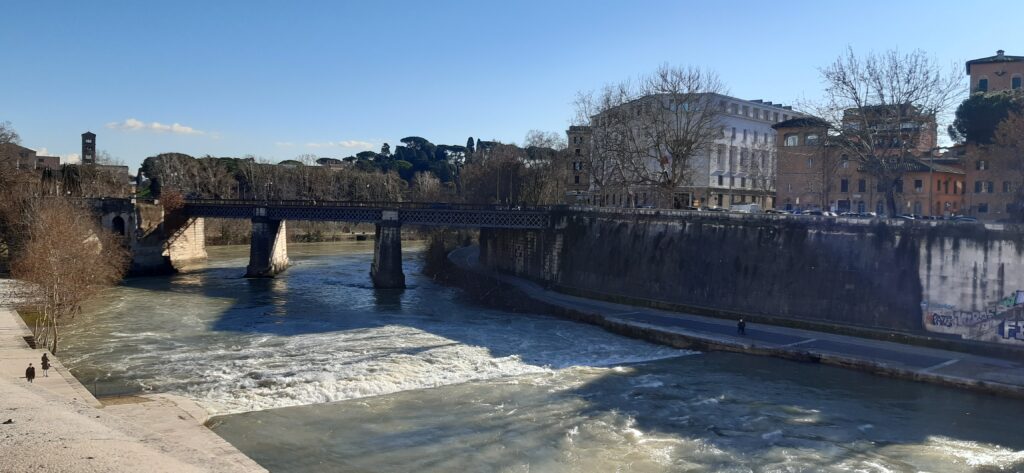The story of the Tiber Island
Italian Version below*
What we read in our guide is it true? Is there an island in Rome?
Well yes! The Tiber Island is the only urban island of the Tiber, for me one of the many places in Rome of inestimable charm.

It is easily accessible, being in a strategic point, and is connected to the banks of the Tiber by two bridges, towards Trastevere we will find Ponte Cestio, in the direction of the Jewish Ghetto Ponte dei 4 Capi or Ponte Fabricio.

If on the one hand the legend tells that the island was born in 509 BC when Tarquinius the Superb, the last king of Rome, was ousted.

People as a sign of hatred towards the tyrant threw the enormous deposit of the King’s grand into the Tiber from the island would later rise.
Other perhaps most famous legend tells that in 291 BC, a terrible plague broke out in Rome, the city’s ambassadors were sent to Epidaurus, a city sacred to Aesculapius, the most important healing god of Greece, with the task of asking the god of medicine for help and bring the message back to Rome.
While the propitiatory rites were taking place, a snake came out of the Temple and took refuge on the Roman ship.
This event was perceived as a positive sign.
The learned ambassadors began the return journey, certain that Aesculapius had transformed into a snake. When the ship arrived near the island, the snake set sail and then disappeared and thus indicate the exact point where the Temple dedicated to Aesculapius would have risen.
On the remains of the Roman temple, the Church of San Bartolomeo all’Isola was later built.
In the sixteenth century, a hospital was built in the area managed by the Congregation of San Giovanni di Dio, the Fatebenefratelli, thus maintaining the tradition of the island as a place of care uninterrupted to this day.
Local tips, Food and Drink:
Follow me: Facebook / Instagram
All rights reserved*
E’ vero ciò che abbiamo letto sulla nostra guida? Esiste un’isola a Roma?
Ebbene si! L’Isola Tiberina è l’unica isola urbana del Tevere, per me uno dei tanti luoghi di Roma di inestimabile fascino.

E’ facilmente raggiungibile essendo in un punto strategico ed è collegata alle sponde del Tevere da due ponti, verso Trastevere troveremo Ponte Cestio, in direzione del Ghetto Ebraico Ponte dei 4 Capi o Ponte Fabricio.

Da una parte narra la leggenda che l’Isola sia nata nel 509 a.C. quando spodestato Tarquinio il Superbo, ultimo re di Roma, il popolo in segno di odio verso il tiranno, abbia gettato nel Tevere l’enorme deposito di grano del Re da cui sarebbe poi sorta l’isola.
Dall’altra, la leggenda forse più famosa, racconta che nel 291 a.C., essendo scoppiata a Roma una spaventosa pestilenza, furono inviati gli ambasciatori della città ad Epidauro, città sacra ad Esculapio, il più importante dio guaritore della Grecia, con il compito di chiedere al nume della medicina soccorso e riportare il messaggio a Roma.

Mentre si svolgevano i riti propiziatori, un serprente uscì dal Tempio e si rifugiò sulla nave romana.
Questo evento fu percepito come un segnale positivo.
I dotti ambasciatori iniziarono il viaggio di ritorno, certi che Esculapio si fosse trasformato in sepente. Quando la nave giunse nei pressi dell’isola il serpente salpò per poi scomparire ed indicare così il punto esatto in cui sarebbe sorto il Tempio dedicato ad Esculapio.
Sui resti del tempio romano fu costruita, in seguito, la Chiesa di San Bartolomeo all’Isola.
Nel Cinquecento, nell’area sorse un ospedale gestito dalla Congregazione di San Giovanni di Dio, i Fatebenefratelli, che hanno mantenuto ininterrotta fino ai nostri giorni, la tradizione dell’Isola come luogo di cura.
Local Tips:
Sostieni la #culturachevince, aiuta la condivisione.
Segui le mie pagine Facebook/Instagram: Selenia_eyeonart
Tutti i diritti sono riservati. E’ vietata qualsiasi utilizzazione, totale o parziale, dei contenuti inseriti nel presente portale, ivi inclusa la memorizzazione, riproduzione, rielaborazione, diffusione o distribuzione dei contenuti stessi mediante qualunque piattaforma tecnologica, supporto o rete telematica, senza previa autorizzazione scritta di Selenia Morgillo.